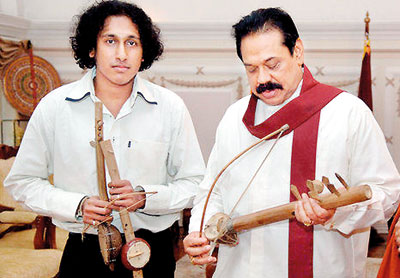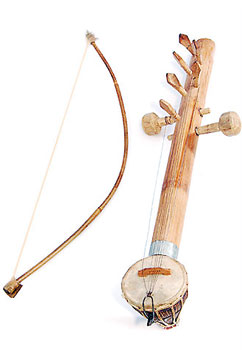Sri Lanka’s Ravanahatha is the world’s first violin
View(s):Sir Christopher Ondaatje investigates the origins of the violin and discovers it all started in Sri Lanka
The violin as we know it today was developed in Italy in the late fifteenth century, but in fact it can trace its true origins back to many centuries to an ancient bowed fiddle, the Ravanahatha, which had originated in the Hela civilisation of Sri Lanka. The instrument was first used during King Ravana’s reign, believed to have been from 2554 to 2517 BC and hence its name, Ravanahatha, which in Sinhala means Ravana’s hand.

Musician Dinesh Subasinghe showing a recreated Ravanahatha to President Mahinda Rajapaksa
This primitive stringed instrument, which produced sad, soulful music, consisted of a bamboo body and coconut shell resonator covered with goat or monkey skin. Some sort of natural fibre was used for the strings, or possibly goat or sheep gut. Modern versions still played in Northern India today, in Rajasthan and Uttar Pradesh, have two principal strings, one of steel, the other of horsehair, with additional horsehair strings.
What makes it the world’s first violin is that it was the first stringed instrument to be played with a bow, an arched stick with a taut string fastened to each end. The musician for the first time rubbed the strings with the bow rather than plucking them with his fingers, and the halved coconut enhanced the resonance. It is believed that the bow was introduced into Europe from Asia by the Arabs.
After being taken from Sri Lanka to India, the Ravanahatha became known as the Ravanastron in the ninth century. When it subsequently reached the Middle East and Europe it underwent several changes. The North African rebab, which had been introduced into Persia, was a forerunner of the more pear-shaped rebec brought to Southern Europe by Muslim merchants and musicians in the eighth century. This in turn evolved into the vielle and the rotte in the Middle Ages in Europe.
After the eleventh century, bowed instruments of two major types were being manufactured in Europe. The first type had a pyriform or pear-shaped resonance box with no neck or pegs, and a flat belly. The second was flat-bodied and oval; it was joined to its back by ribs, and had a distinct neck.
Round sound holes were introduced, which later took on an “f” shape. These instruments, with their four strings, were the forerunners of the violin. A tailpiece and bridge were later added, distinguishing the instruments of the Renaissance from those of the Middle Ages. The viol, developed in the fifteenth century, was superseded by the ancestors of the modern violin, which was perfected by the Amati family of Cremona in the sixteenth and seventeenth centuries.

And so, after many hundreds of years, and a chaotic and well-travelled history, the violin as we know it had emerged. Isn’t it amazing that it had its origins in a simple bamboo and coconut shell instrument played with a primitive bow in Sri Lanka? Recently a reconstructed version of the instrument was presented by musician Dinesh Subasinghe to President Mahinda Rajapaksa.
Follow @timesonlinelk
comments powered by Disqus


